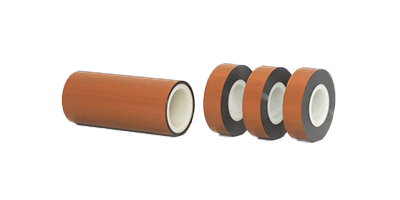What Is a Release Film?

A release film is a film coated with a release agent.
Materials commonly used for release films include polyethylene terephthalate (PET), along with polypropylene (PP) and polyvinyl chloride (PVC), among others. A typical example is the film attached to the adhesive portion of envelopes, which allows them to be easily peeled off for sealing.
Release agents used in release films are typically chemicals applied to mold surfaces in resin product manufacturing, facilitating the easy removal of the product from the mold. Various types of release agents, such as fluorine-based, silicone-based, oil-based, water-based, and powder-based, are selected based on the material type and the manufacturing environment.
Uses of Release Film
Release films, like release agents, are used between molds and resin during resin product manufacturing to ease the removal of the resin from the mold after molding. These films must possess excellent heat resistance.
In manufacturing processes of items like printed circuit boards, flexible printed boards, and multilayer printed circuit boards, release films are utilized during the hot pressing of copper-clad laminated boards or copper foils with prepregs or heat-resistant films. The components to be bonded are sandwiched between release films during hot pressing, and the release film is removed post-bonding.
Additionally, in the manufacturing processes of panels, papers, or other materials using adhesives or coatings, such as adhesives and paints, release films serve as separator films to prevent mutual adhesion of components.
Release films are also used in various applications, including adhesive manufacturing process paper, corrosion-resistant lining, molding release films for carbon fiber-reinforced plastic (CFRP), industrial roll covers, chemical caps, sterile packaging materials, and recyclable label films.
Principles of Release Film
By applying release agents to films like PET, polypropylene, and PVC, release films become non-adhesive and easily detachable from adhesive substances. Their non-adhesive nature means they do not adhere strongly to highly adhesive materials, making them easy to remove. To achieve this, films must exhibit properties like water and oil repellence, resistance to mixing with water, oil, or other chemicals, and a stable molecular structure. Polytetrafluoroethylene (PTFE), commonly known as teflon, is a material with exceptionally high non-adhesive and heat-resistant properties, often used in release agents.
How to Choose Release Film
When selecting a release film, consider the intended use and environment. A variety of release films made from different materials are available in roll or sheet forms, with variations in size.
Each product usually includes clear information about its intended use, aiding in selecting the most suitable option.
Other Information on Release Film
Types of Release Agents
Release agents come in various types, including fluorine-based, silicone-based, oil-based, water-based, and powder-based.
1. Fluorine-Based Release Agents
Fluorine-based release agents are widely used for their excellent heat and chemical resistance.
2. Silicone-Based Release Agents
Silicone-based release agents are cost-effective and environmentally friendly, making them suitable for use in the food and medical industries.
3. Oil-Based Release Agents
Oil-based release agents, known for their high adhesiveness, are utilized in rubber or plastic molding processes.
4. Water-Based Release Agents
Water-based release agents have minimal environmental impact and are user-friendly, making them ideal for household applications.
5. Powder-Based Release Agents
Powder-based release agents are easy to apply, leave minimal residue, and are well-suited for electronic component manufacturing.